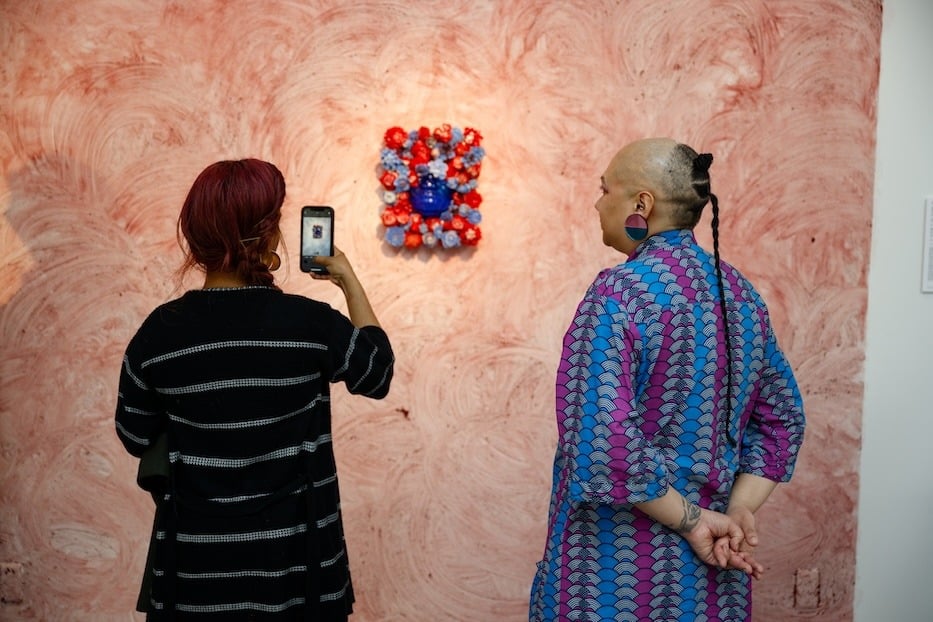Titus Kaphar, A Pillow for Fragile Fictions, 2016. Blown glass with rum, tamarind, lime & molasses on marble base. Behind it is Layo Bright, Bloom in hues of Red, Pink, Purple, 2024. Cast, blown, fused, mirrored glass and 23k gold leaf on custom frame. John Shylsoki Photos.
Walk around Titus Kaphar’s sculpture A Pillow for Fragile Fictions at just the right angle, and you’ll start to see the soft curves of a nose and lips emerge from the slumped glass vessel. There, George Washington’s distorted head rests sideways and ignobly on a white pillow fashioned from marble. Inside the glass form, an earthy brown liquid of tamarind, rum, lime, and molasses represents the sundry items the Founding Father and first president of the United States received in return for trading one of his enslaved men.
Here, Kaphar handily puts to bed the prestige associated with this iconic figure of American history. It begins the thesis of glass as a medium of critical redress in the exhibition All At Once, Reflected Through Glass. Curated by NXTHVN 2024-2025 Curatorial Fellow Rigoberto Luna, this powerful group exhibition runs through May 18, forging connections between the site of the arts incubator, its industrial history, and the medium of glass.
The fact that two former glass manufacturers—H. Puddicombe & Company and the Macalaster Bicknell Company—previously occupied the building that now houses NXTHVN provided the impetus to collect contemporary works representing the range of the medium.
.jpg?width=933&height=622&name=All%20At%20Once%2c%20Reflected%20Through%20Glass(3).jpg)
John Shylsoki Photos. The photo below is Timo Fahler, it’s happening, can you feel it (my inheritance) 2022-23. Stained glass, lead, plaster, aluminum.
Stained glass (circa 1920s–40s) displayed on a brick wall near the welcome desk demonstrates the type of work made by the former company, which specialized in art and leaded glass akin to those sometimes found in places of worship. This pair of stained glass sample windows were given to a NXTHVN staff member shortly before its opening, and the presence of these works by an unknown maker in the main entrance is a nod to the type of unrecognized work that this exhibition endeavors to amend—one of many, layered agendas in this show.
With their soft colors and pearlescent surfaces, the calming aesthetic of these small windows is counterbalanced by a vibrant black and green neon work on an adjacent wall. Bold capital letters read “Black Owned.” Los Angeles-based visual artist Patrick Martinez’s piece highlights that the building is no longer under white ownership—a contrast from the previous two inhabitants.
.jpg?width=350&height=525&name=All%20At%20Once%2c%20Reflected%20Through%20Glass(10).jpg)
Back inside the main exhibition space, beyond Kaphar’s imposing sculpture, another work grapples with personal histories. In Timo Faher’s it’s happening, can you feel it (my inheritance), a sculpture of a hand protruding from the wall precariously dangles a stained-glass replica of a .45 caliber 1911 pistol—an object bequeathed to the artist and his brothers after their father died.
The chalky brown hue of the hand drains to a bone white at the fingers, which appear to be left the color of untreated plaster. Thick leading joins the facets of the gun, made from translucent planes of gray glass allowing you to see into and through the weapon. With its abstemious construction, the gun appears delicate yet solidly constructed, the title and positioning of the hand both pointing to the artist’s ambivalence about what it may mean to receive this object or engage with this country’s fraught relationship with guns.
Another aim of this exhibition is to subvert the traditional narrative of glassmaking as a predominantly white art form, and two stunning and elaborate portraits by Layo Bright pull from the artist’s Nigerian heritage. Bloom of Hues of Red, Pink, Purple portrays Bright’s sister, rendered in matte glass and surrounded by small, shiny replicas of blown, fused, and individually cast flowers, all native to Nigeria. Eyes obscured by the floral motif, the sculpture is an opulent meditation on family, memory, and nature placed within a larger examination of what is inherited and what can be reclaimed. 
.jpg?width=933&height=622&name=All%20At%20Once%2c%20Reflected%20Through%20Glass(6).jpg)
Angela Babby, Supreme Respect for the Two Spirits, 2013. Print on paper of Kiln-fired Enamel. John Shylsoki Photos.
All At Once, Reflected Through Glass elevates the craft of glass by including artists who embrace the medium to tackle challenging societal narratives or share personal stories, the two often merging in complicated and surprising ways. The artists address many pressing and contemporary topics—racism, gun violence, migration, among other issues—and at the same time, the technical feats of the work surface as a strong undercurrent throughout this group exhibition.
The contradictory nature of glass—known for being fragile yet perceived as strong—lends itself to reflect and amplify the challenging topics at hand, asserting the medium of glass as a vessel of resistance.
All At Once, Reflected Through Glass continues through May 18, 2025, at NXTHVN, 169 Henry Street, New Haven, CT 06511.